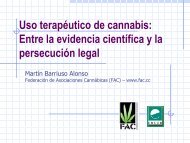Les Rencontres de Biarritz 2007 - THS 10
Les Rencontres de Biarritz 2007 - THS 10
Les Rencontres de Biarritz 2007 - THS 10
Create successful ePaper yourself
Turn your PDF publications into a flip-book with our unique Google optimized e-Paper software.
A NON-INVASIVE METHOD OF LIVER STIFFNESS MEASUREMENT WITH<br />
ULTRASONIC TRANSIENT ELASTOGRAPHY. ACCEPTABILITY AND IMPACT<br />
AMONG IN-TREATMENT SUBSTANCE DEPENDENT INDIVIDUALS.<br />
RÉSUMÉ / ABSTRACT<br />
BELTRAN V<br />
AGUERRETXE-COLINA A<br />
OUI B<br />
DUBERNET J<br />
DAULOUEDE J-P<br />
AURIACOMBE M<br />
Objective: To <strong>de</strong>scribe the acceptability of a non-invasive liver stiffness measurement for<br />
patients attending addiction treatment within addiction based settings.<br />
Methods: Liver stiffness was measured with ultrasonic transient elastography (UTE) using<br />
FibroScan®, (Echosens, Paris, France). This is a 5-minute non-invasive and painless examination.<br />
The results are immediately provi<strong>de</strong>d as a quantitative value (kPa). Subjects were recruited<br />
in addiction treatment clinics and office-based-practice addiction treatment settings in the<br />
metropolitan area of Bayonne, Aquitaine, France, in July 2006. General patient information<br />
related to addiction treatment, liver medical history, acceptability of the procedure and its<br />
impact on attitu<strong>de</strong> regarding hepatic status was assessed by questionnaire.<br />
Results: 94 patients (sex ratio M/F 3:1, aged 45 years SD= 9) were interviewed. 32% were in<br />
opioid agonist pharmacotherapy for primary opiate <strong>de</strong>pen<strong>de</strong>nce. 89% had knowledge of serostatus.<br />
16% of these were HIV positive and 76% were HCV positive. All of those interviewed<br />
accepted the UTE procedure. None reported discomfort or pain. UTE values ranged from 3.2<br />
to 75 kPa. 65.5% were consi<strong>de</strong>red as having no fibrosis (below stage F2) and 1.3% as having<br />
significant cirrhosis in need for treatment and many accepted liver related treatment for which<br />
they had been reluctant. Subjects with hepatitis C showed significantly higher Fibroscan®<br />
scores than those without (<strong>10</strong>.3 vs 6.8). 97% of subjects reported the procedure to be useful<br />
and 99% of them would agree for another appointment for a Fibroscan® test.<br />
Conclusion: With this high risk group of in-treatment substance users acceptability of fibrosis<br />
assessment with a non-invasive procedure was very high, and many changed attitu<strong>de</strong> regarding<br />
possible hepatitis treatment as a consequence<br />
MOTS CLÉS / KEYWORDS<br />
Hépatite, foie, tolérance<br />
Hepatitis, liver, tolerance<br />
V. Beltran (2,1); A. Aguerretxe-Colina, (1,2); B. Oui (3); J. Dubernet (2); J-P. Daulouè<strong>de</strong> (1,2); M.<br />
Auriacombe, (2).<br />
(1) Centre d’addictologie, BIZIA, Bayonne, France.<br />
(2) Addiction Psychiatry, JE2358, INSERM IFR 99, Université Victor Segalen Bor<strong>de</strong>aux 2, Bor<strong>de</strong>aux, France.<br />
(3) Service d’hépato-gastro-entérologie, CH Côte Basque, Bayonne, France<br />
191
















